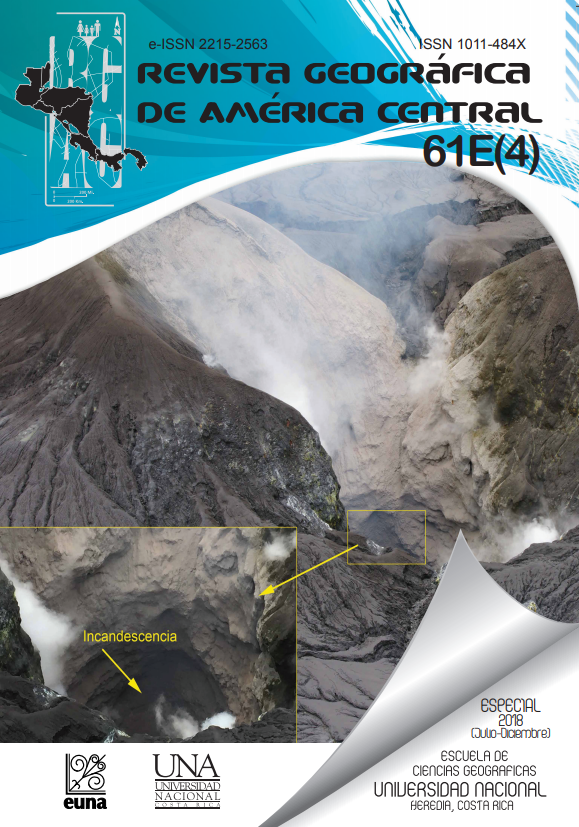Development of acoustic maps in Heredia, Alajuela and Belén counties, as indicators of noise pollution.
DOI:
https://doi.org/10.15359/rgac.61-4.9Keywords:
Alajuela, Belén, Noise pollution, Heredia, acoustics mapsAbstract
The present study corresponds to the conformation of acoustic maps based on the collection of noise data in the urban centers of Heredia, Alajuela and Belén, in Costa Rica donwtown. Therefore, a sampling was carried out using sites of complaint for noise pollution in Alajuela and Belén, while in Heredia the vertices of each quadrants in Central District were used as a sampling site. The most important result obtained in this study is related to the identification of mostly sites with
noise levels that exceed the permissible limits established in the Regulation that can be observed graphically in the acoustic maps. This leads to the following conclusion the acoustic maps represent a fundamental tool for the noise control and to plan the mitigation strategies and confinement of noise pollution areas.
References
Geotecnologías (2014). Distritos de Costa Rica [capa vectorial] del Atlas Digital de Costa Rica 2014.
Caracausi, R. (2014). Application of geographic information systems (GIS) and noise mapping of noise in urban structures. The 21 International Congress on Sound and Vibration. China. 8pp.
Gray, A. (2017). These are the cities with the worst noise pollution. Recuperado de:
https://www.weforum.org/agenda/2017/03/these-are-the-cities-with-the-worst-noise-pollution/
Presidencia de la República y Ministerio de Salud (2015). Decreto N 39200-S. 2015. Reglamento para el Control de Contaminación por Ruido. Diario Oficial La Gaceta 197. San José.
Hong, J. y Jeon, J. (2014). Soundscape mapping in urban contexts using GIS techniques. Hanyang University, Korea. Inter noise 2014, Melbourne, Australia, 16 - 19 November. 5 pp.
Instituto Geográfico Nacional (IGN). (2014). Redcamino 2014 [capa vectorial]. Escala 1: 50000. Hojas Cartográficas escala 1: 50000. 2004. Atlas Digital de Costa Rica 2014.
Norma ISO 1996-2 (2009). Descripción, medición y evaluación del ruido ambiental, Parte 2: Determinación de los niveles de ruido ambiental. ES.
Kovak, C., Copeland, T., Elder, N., Thomas, N. y Ule, H. (2009). Acoustic Impact of the Green Corridor Action Group’s Urban Design Using Acoustic Mapping. Canadian Acoustics 37 (4): 3-11.
Kurakula, V. (2007). A GIS– based approach for 3D noise modelling using 3D city models. ITC. The Netherlands.
Lazar, J., Bruce, D., Giordiano, S., Levin, D., Little, C. ySlacum, W. (2007). Acoustic mapping and GIS aiden oyster restoration. Proceeding of Costal Zone 07. Portland, Oregon.
MER. (2011). Mapa Estratégico de Ruido de Madrid. Madrid. España.
Murillo, D., Ortega, I., Carrillo, J., Pardo, A., Rendón, J. (2012). Comparación de métodos de interpolación para la generación de mapas de ruido en entornos urbanos. Ing. USB med 1 (3): 62—68.
Rejano, M (2000). Ruido Industrial y Urbano. ES, Paraninfo Thomson Leaning..
Szczodrak, M., Kotus, J., Czyzewski, A., Kostek, B. (2013). The application of noise mapping tool deployed in grid infrastructure for creating noise maps of urban areas. Computer Science 14 (2) 231—242.
Villatoro, M., Henríquez, C., Sancho, F. (2008). Comparación de los interpoladores IDW y Kriging en la variación espacial de pH, CA, Cice y P del Suelo. Agronomía Costarricense 32 (1) 95—105.
Wang, B. y Kang, J. (2011). Effects of urban morphology on the traffic noise distribution through noise mapping: A comparative study between UK and China. Applied Acoustics 72, 556–568.
Yepes, D., Gómez, M., Sánchez, L. y Jaramillo, A. (2009). Metodología de elaboración de mapas acústicos como herramienta de gestión del ruido urbano caso Medellín. Dyna. No 158, 29-40.
Verdú, V. (2010). Medición y evaluación de la incertidumbre de auditorías en el aislamiento acústico. Universidad Politécnica de Valencia. España.
Downloads
Published
How to Cite
Issue
Section
License
Proposed policy for journals offering Open Access
Authors publishing their works in the Journal acknowledge and agree to the following terms:
a) Authors retain the copyrights to their works and guarantee the Journal the right to be the first to publish their works, under the Creative Commons License Attribution-NonCommercial-ShareAlike 4.0 International, CC BY-NC-SA 4.0 International (https://creativecommons.org/licenses/by-nc-sa/4.0/deed.es), which allows others to share works upon complying with the acknowledgment of authorship and mention of the Journal as the original publisher of the work.
b) Authors are permitted to separately establish additional agreements for the non-exclusive distribution of the official edition of the work published in the Journal (for example, authors may desire to place the work in an institutional repository or incorporate it into a book that is to published elsewhere) so long they acknowledgment to recognize the Journal as the original publisher. The aforementioned additional agreements must respect the terms of the non-profit character and sharing philosophy of the original license (CC BY-NC-SA 4.0 International, https://creativecommons.org/licenses/by-nc-sa/4.0/deed.es).
c) Authors are encouraged to archive the post-print or editor/PDF version in Open Access repositories.






 REVGEO is licensed under https://creativecommons.org/licenses/by-nc-sa/4.0/deed.es
REVGEO is licensed under https://creativecommons.org/licenses/by-nc-sa/4.0/deed.es
.svg_4.png)

_(1).png)
_(1)_(1)_(1)_1.png)
(2)(1)(1)(1).png)
